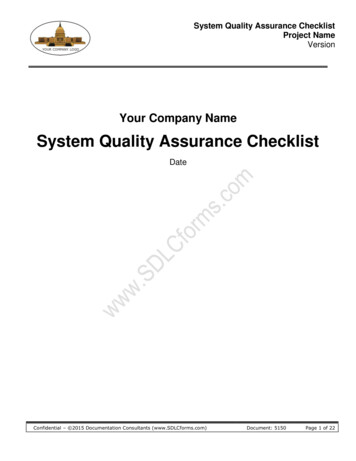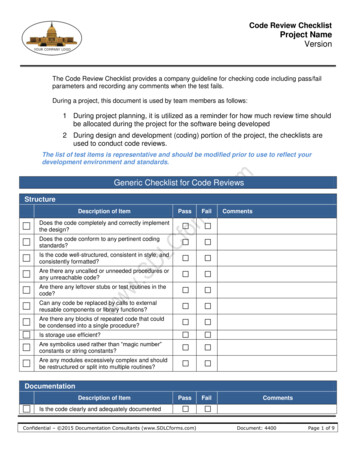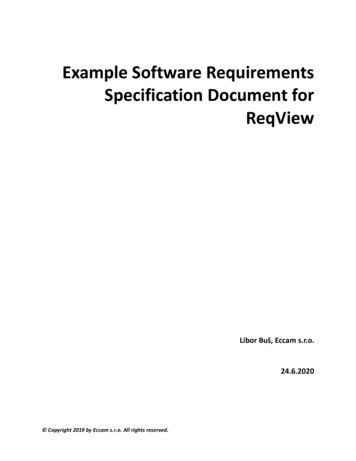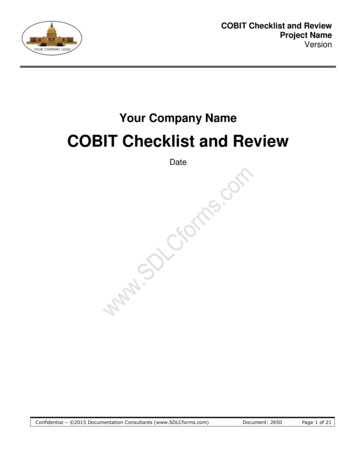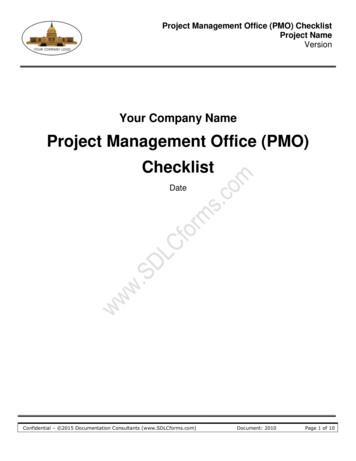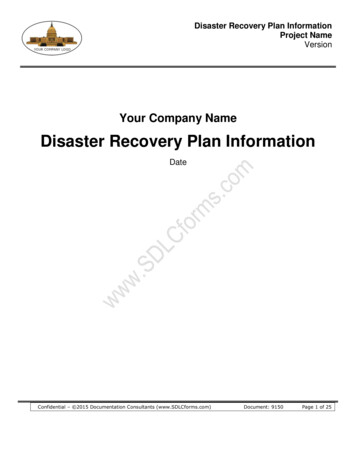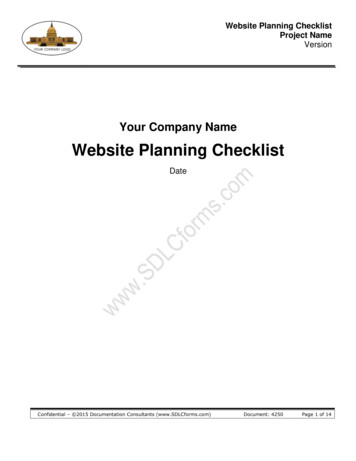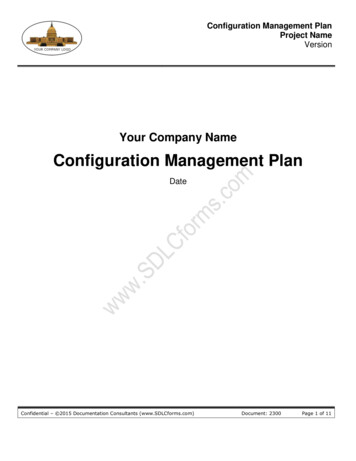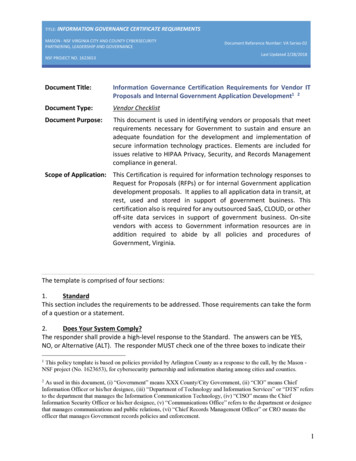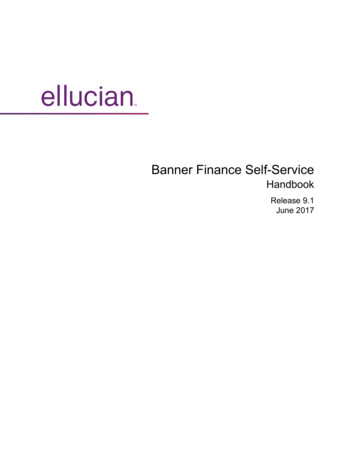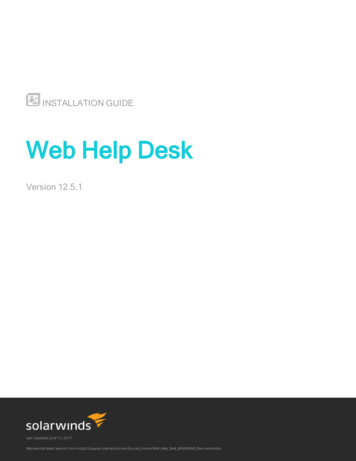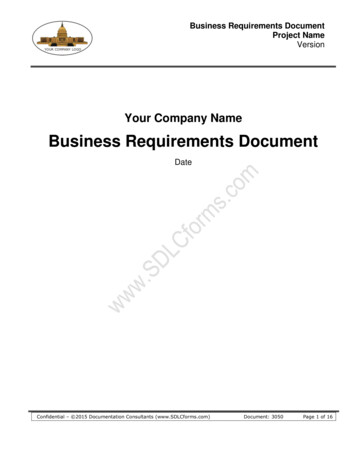
Transcription
Business Requirements DocumentProject NameVersionYour Company NameBusiness Requirements DocumentDateConfidential – 2015 Documentation Consultants (www.SDLCforms.com)Document: 3050Page 1 of 16
Business Requirements DocumentProject NameVersionConfidential – 2015 Documentation Consultants (www.SDLCforms.com)Document: 3050Page 2 of 16
Business Requirements DocumentProject NameVersionRevision HistoryDateVersionAuthorChangeCOPYRIGHT NOTICEConfidential – 2015 Documentation ConsultantsAll rights reserved. These materials are for internal use only. No part of these materials may bereproduced, published in any form or by any means, electronic or mechanical, including photocopy or anyinformation storage or retrieval system, nor may the materials be disclosed to third parties without the writtenauthorization of (Your Company Name).Confidential – 2015 Documentation Consultants (www.SDLCforms.com)Document: 3050Page 3 of 16
Business Requirements DocumentProject NameVersionTable of Contents1 Purpose . 52 Project Information . 52.12.22.32.42.52.62.72.82.9Project Description . 5Project Approach. 5Goals, Objectives, and Scope . 6Business Drivers . 6Stakeholders . 6Assumptions, Dependencies, and Constraints . 6Risks . 6Costs. 7Delivery Dates . 73 Process Information. 83.1Current Processes . 83.1.1 Current Process Flow. 83.1.2 Current Process Description . 83.2New Processes or Future Enhancements . 93.2.1 New Process Flow . 93.2.2 New Process Description . 94 Requirements Information . 104.14.24.3High-Level Business Requirements. 10System Interfaces . 10Infrastructure Requirements . 115 Other requirements Information . 125.15.25.35.45.5Product, Organizational, System, and External Requirements . 12Usability, Performance, Operations, and Maintenance Requirements . 13Content / Data / Sample Report Requirements . 13Screen Requirements . 14Training and Documentation Requirements . 146 Glossary . 157 APPENDIX . 16Confidential – 2015 Documentation Consultants (www.SDLCforms.com)Document: 3050Page 4 of 16
Business Requirements DocumentProject NameVersionNote: Text displayed in blue italics is included to provide guidance to the author and shouldbe deleted before publishing the document. In any table, select and delete any blue linetext; then click Home Styles and select “Table Text” to restore the cells to the defaultvalue.Business Requirements Document defines the general business requirements for the project. Alsoidentifies business and end user requirements, problems or issues, project information, processinformation, and training and documentation requirements.1PurposePurpose describes the intent of the document, which is to define the business requirementsfor the project. 2Problems or issues to resolve.Objectives or goals met with this solution.Solution to be implemented.Why the solution is being implemented.Project InformationThis section of the document should contain project background information including theproject’s purpose, objectives, and major system functionality.2.1Project DescriptionThe Project Description section provides a high level general view of the project;background, vision, approach, timeframe, etc.2.2Project ApproachThe Project Approach statement provides a complete description of the approach to betaken for the delivery of the project. Outline the phases of the project including the highlevel activities. If applicable, describe how a specific phase relates to the overall project.Confidential – 2015 Documentation Consultants (www.SDLCforms.com)Document: 3050Page 5 of 16
Business Requirements DocumentProject NameVersion2.3Goals, Objectives, and ScopeThe objectives statement describes the goals of the project. The Project Scope statementdefines the scope of the project.List the high-level project deliverables and specify whether they are included or excludedfrom the project.ID2.4Included/ExcludedDescriptionBusiness DriversDescribe why the project is being implemented. This may be to reduce costs, increaserevenue, streamline processes, etc.2.5StakeholdersThe Stakeholders statement and table outlines the project stakeholders and their respectiveroles.NameJohn , Dependencies, and ConstraintsList assumptions, dependencies, and constraints that could constrain the project team,development, or implementation, e.g., system hardware or software availability or access.2.7RisksProvide information about any risks associated with the project. Provide any work-around ormitigation information for each risk identified.Confidential – 2015 Documentation Consultants (www.SDLCforms.com)Document: 3050Page 6 of 16
Business Requirements DocumentProject NameVersion2.8CostsProvide estimated total costs for implementing the proposed solution. These amountsshould be detailed in a Project Capital and Expense Costs Worksheet, if applicable. Note anyassumptions used to estimate the costs.2.9Delivery DatesList high-level deliverables / milestones for the project and their associated target dates.Milestones / DeliverablesConfidential – 2015 Documentation Consultants (www.SDLCforms.com)Target DateDocument: 3050Page 7 of 16
Business Requirements DocumentProject NameVersion3Process Information3.1Current ProcessesProvide Business Process Diagrams for any complex processes or steps that are used to doa specific job. Consider systems involved, users, when tasks are performed, and what theresults are. Describe the process using text or a graphic process flow.Any business rules, such as calculations, decisions / if-then, algorithms, or proceduresshould be clearly defined and broken down to their individual steps. Include the followinginformation in the process diagrams: Inputs, processes, and outputsBusiness workflowBusiness rules, edits, validations, and/or formulasException handling and processing.3.1.1 Current Process FlowProvide detailed information about current processes.3.1.2 Current Process DescriptionProvide detailed step information about current processes in the following table, al – 2015 Documentation Consultants (www.SDLCforms.com)Document: 3050Page 8 of 16
Business Requirements DocumentProject NameVersion3.2New Processes or Future EnhancementsProvide Business Process Diagrams for any new complex processes or steps that must beperformed to do a specific job. Consider systems involved, users, when tasks areperformed, and what the results are. Describe the process using text or a graphic processflow.Any business rules, such as calculations, decisions / if-then, algorithms, or proceduresshould be clearly defined and broken down to the individual steps. Include the followinginformation in the process diagrams: Inputs, processes, and outputsBusiness workflowBusiness rules, edits, validations, and/or formulasException handling and processing.3.2.1 New Process FlowProvide detailed information about the new processes.3.2.2 New Process DescriptionProvide detailed step information about the new processes in the following table, al – 2015 Documentation Consultants (www.SDLCforms.com)Document: 3050Page 9 of 16
Business Requirements DocumentProject NameVersion4Requirements Information4.1High-Level Business RequirementsThis section includes details about the business requirements. Business requirements arethose items needed to support user goals, tasks, and activities. It may include high-levelmodifications or enhancements. They can be either mandatory or desirable. Mandatory: “Must Have” represents the core functionality and must be included in thesolution.Desirable: “Nice to Have” requirements can be implemented after all mandatoryrequirements are fulfilled and there are sufficient resources available.This section should also include business rules that impact the project. A Business Ruledefines or constrains some aspect of the business, e.g., products sold with a 50% or morediscount must include an authorized approval code.#FunctionDescriptionPriorityCommentsNote: Priority may be defined as Mandatory or Desirable.4.2System InterfacesProvide information about the systems or applications that the solution must interface with,e.g., Communication hardware, software and their requirements, methods, and functionality.Data, formats, messages, and transfer schedules.Performance and capacity.Security designs and considerations.Names of reference manuals and other documentation along with their location.Confidential – 2015 Documentation Consultants (www.SDLCforms.com)Document: 3050Page 10 of 16
Business Requirements DocumentProject NameVersion4.3Infrastructure RequirementsProvide infrastructure information when there are equipment / network additions or changes,e.g., servers, printers, network devices, network configuration or management changes, newor upgraded middleware or operating system software, or changes to data centers.Confidential – 2015 Documentation Consultants (www.SDLCforms.com)Document: 3050Page 11 of 16
Business Requirements DocumentProject NameVersion5Other Requirements Information5.1Product, Organizational, System, and External RequirementsThis section includes details about other requirements that can cover products,organizations, systems (e.g., performance, operations), and external requirements (e.g.,security).AudienceIndicate the users of the system or applicationSecurityProvide information about the standard or unique security systemor application situations, e.g., access / authentication /authorization processes; client, user or server certificates;encryption, password rules, and security procedures.Volume andPerformanceMetricsIndicate system or application volume and performance metrics tobe performed, e.g., database records or transactions to beprocessed within a certain time period.Capacity andScalabilityIndicate capacity and growth information or concerns that willhave to be met over time.SupportConsiderationsIndicate system or application support, e.g., who will support it,hardware / software to support it, service level agreements orcontractual obligations.AuditIndicate any system or application audit requirements orconstraints.DesignConstraintsIndicate system or application design constraints, e.g., softwarelanguages, developmental tools, architectural and designconstraints.OutputIndicate reports, files or other export output.Data RetentionIndicate any special data retention requirements.Legal orRegulatoryIndicate any legal or regulatory requirements that can impact thesystem or application.Confidential – 2015 Documentation Consultants (www.SDLCforms.com)Document: 3050Page 12 of 16
Business Requirements DocumentProject NameVersion5.2Usability, Performance, Operations, and Maintenance RequirementsProvide requirements information related to product usability, system performance,operations, maintenance or conditions that must be met by the proposed application orsystem. These requirements can have a more detailed title / description or be in a tsContent / Data / Sample Report RequirementsInclude information about reports or data that must be provided or modified, e.g., Samples of all content and data.Examples of input / output files and their schema.List all necessary content with a brief description.Who will provide the information? List will provide the information and who isresponsible for what and when, e.g., one-time only, other content must be maintained ona regular daily, weekly, or monthly basis.Who will maintain the information when the application is operational?Confidential – 2015 Documentation Consultants (www.SDLCforms.com)Document: 3050Page 13 of 16
Business Requirements DocumentProject NameVersion5.4Screen RequirementsProvide any business rules or information related to screen information that must beincluded.Element5.5Description & RulesSourceReqDefault ValueTraining and Documentation RequirementsProvide training and documentation information that is required to support the applicationor system to be implemented, e.g., training plans, training materials, support documentation,and user documentation.Training / DocumentationResourceConfidential – 2015 Documentation Consultants (www.SDLCforms.com)ScheduleCommentsDocument: 3050Page 14 of 16
Business Requirements DocumentProject NameVersion6GlossaryList any document terms that may not be fully understood without some ness requirements identify a necessary attribute, capability, characteristic,or quality of a system that has value and utility to a user.Sets of requirements are used as input into the design stages of productdevelopment. The requirements phase can be preceded by a feasibility studyor a conceptual analysis phase of the project.Requirements-gather requirements from stakeholders.Analysis-check for consistency and completeness.Definitions-write down descriptive requirements for developers.Specifications-create details that are an initial bridge between requirementsand design.FunctionalRequirementsFunctional requirements define the internal workings of the software, i.e., thecalculations, technical details, data manipulations, and other specificfunctionality that show how the events are to be satisfied.The core of the requirement is the description of the required behavior, whichmust be a clear and readable description of the behavior. This behavior cancome from organizational or business rules, or it can be discovered throughworking sessions with users, stakeholders, and other experts within theorganization.Functional requirements generally contain a unique name and number, a briefsummary, and reason for it. This information is used to help the readerunderstand why the requirement is needed, and to track the requirementthrough the development of the system.Functional requirements are supported by non-functional requirements, whichimpose constraints on the design or implementation.Confidential – 2015 Documentation Consultants (www.SDLCforms.com)Document: 3050Page 15 of 16
Business Requirements DocumentProject l requirements specify criteria that can be used to judge theoperation of a system, rather than specific behaviors. They impose constraintson the design or implementation.Typical non-functional requirements are performance, reliability, security,scalability, and cost. Other terms for non-functional requirements are"constraints", "quality attributes" and "quality of service requirements."7APPENDIXConfidential – 2015 Documentation Consultants (www.SDLCforms.com)Document: 3050Page 16 of 16
Business Requirements Business requirements identify a necessary attribute, capability, characteristic, or quality of a system that has value and utility to a user. Sets of requirements are used as input into the design stages of product development. The requirements phase can be preceded by a feasibility study
